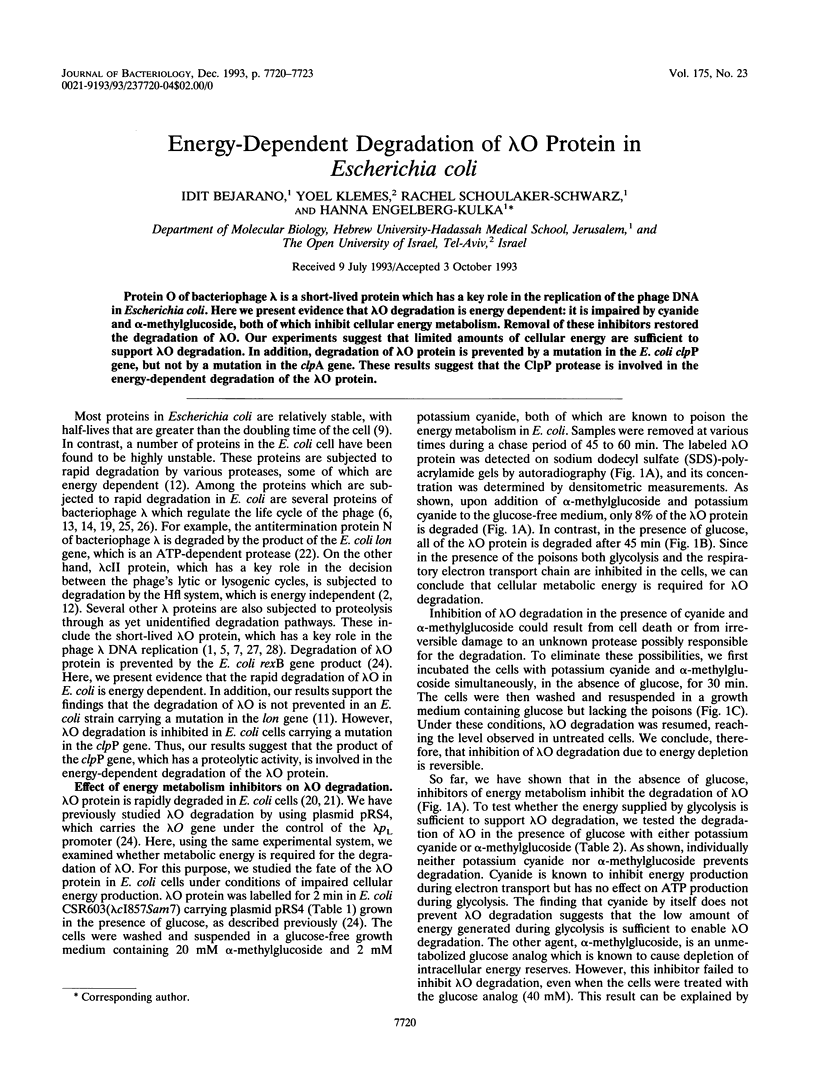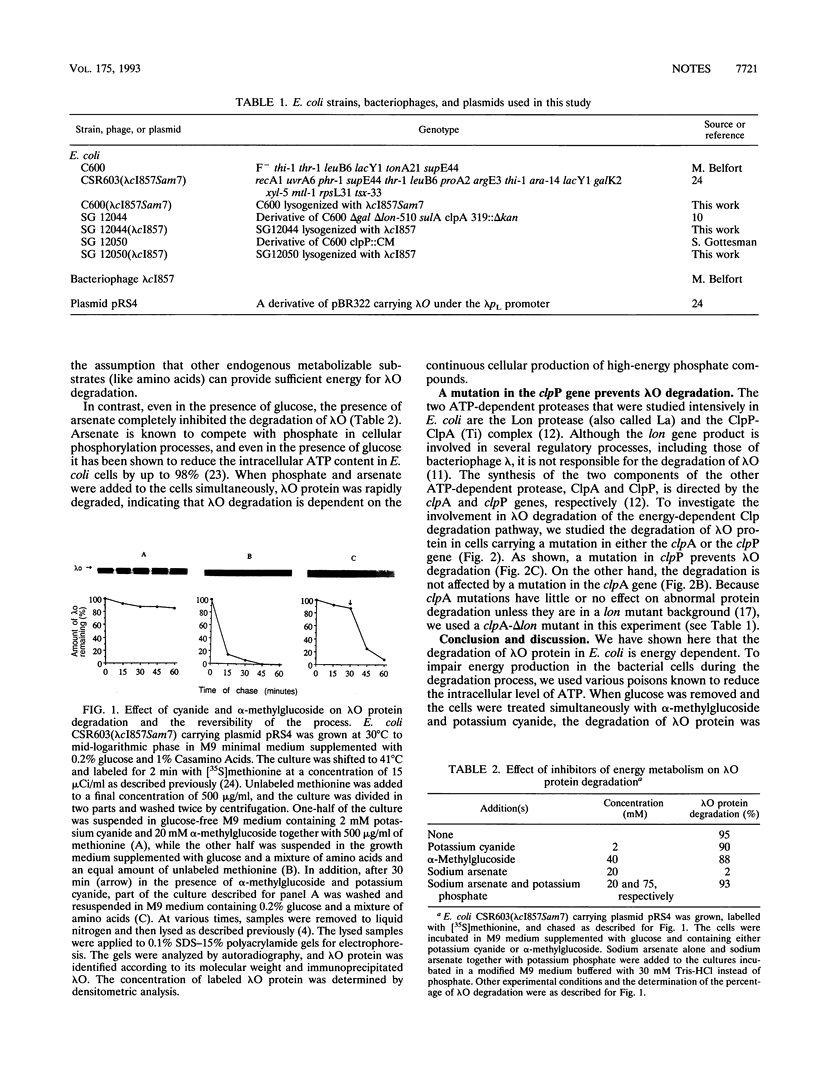Abstract
Protein O of bacteriophage lambda is a short-lived protein which has a key role in the replication of the phage DNA in Escherichia coli. Here we present evidence that lambda O degradation is energy dependent: it is impaired by cyanide and alpha-methylglucoside, both of which inhibit cellular energy metabolism. Removal of these inhibitors restored the degradation of lambda O. Our experiments suggest that limited amounts of cellular energy are sufficient to support lambda O degradation. In addition, degradation of lambda O protein is prevented by a mutation in the E. coli clpP gene, but not by a mutation in the clpA gene. These results suggest that the ClpP protease is involved in the energy-dependent degradation of the lambda O protein.
Full text
PDF



Images in this article
Selected References
These references are in PubMed. This may not be the complete list of references from this article.
- Alfano C., McMacken R. Heat shock protein-mediated disassembly of nucleoprotein structures is required for the initiation of bacteriophage lambda DNA replication. J Biol Chem. 1989 Jun 25;264(18):10709–10718. [PubMed] [Google Scholar]
- Cheng H. H., Muhlrad P. J., Hoyt M. A., Echols H. Cleavage of the cII protein of phage lambda by purified HflA protease: control of the switch between lysis and lysogeny. Proc Natl Acad Sci U S A. 1988 Nov;85(21):7882–7886. doi: 10.1073/pnas.85.21.7882. [DOI] [PMC free article] [PubMed] [Google Scholar]
- Damerau K., St John A. C. Role of Clp protease subunits in degradation of carbon starvation proteins in Escherichia coli. J Bacteriol. 1993 Jan;175(1):53–63. doi: 10.1128/jb.175.1.53-63.1993. [DOI] [PMC free article] [PubMed] [Google Scholar]
- Dekel-Gorodetsky L., Schoulaker-Schwarz R., Engelberg-Kulka H. Escherichia coli tryptophan operon directs the in vivo synthesis of a leader peptide. J Bacteriol. 1986 Mar;165(3):1046–1048. doi: 10.1128/jb.165.3.1046-1048.1986. [DOI] [PMC free article] [PubMed] [Google Scholar]
- Dodson M., McMacken R., Echols H. Specialized nucleoprotein structures at the origin of replication of bacteriophage lambda. Protein association and disassociation reactions responsible for localized initiation of replication. J Biol Chem. 1989 Jun 25;264(18):10719–10725. [PubMed] [Google Scholar]
- Geuskens V., Mhammedi-Alaoui A., Desmet L., Toussaint A. Virulence in bacteriophage Mu: a case of trans-dominant proteolysis by the Escherichia coli Clp serine protease. EMBO J. 1992 Dec;11(13):5121–5127. doi: 10.1002/j.1460-2075.1992.tb05619.x. [DOI] [PMC free article] [PubMed] [Google Scholar]
- Goldberg A. L., St John A. C. Intracellular protein degradation in mammalian and bacterial cells: Part 2. Annu Rev Biochem. 1976;45:747–803. doi: 10.1146/annurev.bi.45.070176.003531. [DOI] [PubMed] [Google Scholar]
- Gottesman S., Gottesman M., Shaw J. E., Pearson M. L. Protein degradation in E. coli: the lon mutation and bacteriophage lambda N and cII protein stability. Cell. 1981 Apr;24(1):225–233. doi: 10.1016/0092-8674(81)90518-3. [DOI] [PubMed] [Google Scholar]
- Gottesman S., Maurizi M. R. Regulation by proteolysis: energy-dependent proteases and their targets. Microbiol Rev. 1992 Dec;56(4):592–621. doi: 10.1128/mr.56.4.592-621.1992. [DOI] [PMC free article] [PubMed] [Google Scholar]
- Gottesman S. Minimizing proteolysis in Escherichia coli: genetic solutions. Methods Enzymol. 1990;185:119–129. doi: 10.1016/0076-6879(90)85013-e. [DOI] [PubMed] [Google Scholar]
- Greenblatt J. Regulation of the expression of the N gene of bacteriophage lambda. Proc Natl Acad Sci U S A. 1973 Feb;70(2):421–424. doi: 10.1073/pnas.70.2.421. [DOI] [PMC free article] [PubMed] [Google Scholar]
- Herskowitz I., Hagen D. The lysis-lysogeny decision of phage lambda: explicit programming and responsiveness. Annu Rev Genet. 1980;14:399–445. doi: 10.1146/annurev.ge.14.120180.002151. [DOI] [PubMed] [Google Scholar]
- Hwang B. J., Park W. J., Chung C. H., Goldberg A. L. Escherichia coli contains a soluble ATP-dependent protease (Ti) distinct from protease La. Proc Natl Acad Sci U S A. 1987 Aug;84(16):5550–5554. doi: 10.1073/pnas.84.16.5550. [DOI] [PMC free article] [PubMed] [Google Scholar]
- Hwang B. J., Woo K. M., Goldberg A. L., Chung C. H. Protease Ti, a new ATP-dependent protease in Escherichia coli, contains protein-activated ATPase and proteolytic functions in distinct subunits. J Biol Chem. 1988 Jun 25;263(18):8727–8734. [PubMed] [Google Scholar]
- Katayama-Fujimura Y., Gottesman S., Maurizi M. R. A multiple-component, ATP-dependent protease from Escherichia coli. J Biol Chem. 1987 Apr 5;262(10):4477–4485. [PubMed] [Google Scholar]
- Katayama Y., Gottesman S., Pumphrey J., Rudikoff S., Clark W. P., Maurizi M. R. The two-component, ATP-dependent Clp protease of Escherichia coli. Purification, cloning, and mutational analysis of the ATP-binding component. J Biol Chem. 1988 Oct 15;263(29):15226–15236. [PubMed] [Google Scholar]
- Konrad M. W. Dependence of "early" lambda bacteriophage RNA synthesis on bacteriophage-directed protein synthesis. Proc Natl Acad Sci U S A. 1968 Jan;59(1):171–178. doi: 10.1073/pnas.59.1.171. [DOI] [PMC free article] [PubMed] [Google Scholar]
- Lipińska B., Podhajska A., Taylor K. Synthesis and decay of lambda DNA replication proteins in minicells. Biochem Biophys Res Commun. 1980 Jan 15;92(1):120–126. doi: 10.1016/0006-291x(80)91528-4. [DOI] [PubMed] [Google Scholar]
- Maurizi M. R. Degradation in vitro of bacteriophage lambda N protein by Lon protease from Escherichia coli. J Biol Chem. 1987 Feb 25;262(6):2696–2703. [PubMed] [Google Scholar]
- Schoulaker-Schwarz R., Dekel-Gorodetsky L., Engelberg-Kulka H. An additional function for bacteriophage lambda rex: the rexB product prevents degradation of the lambda O protein. Proc Natl Acad Sci U S A. 1991 Jun 1;88(11):4996–5000. doi: 10.1073/pnas.88.11.4996. [DOI] [PMC free article] [PubMed] [Google Scholar]
- Schwartz M. On the function of the N cistron in phage lambda. Virology. 1970 Jan;40(1):23–33. doi: 10.1016/0042-6822(70)90375-2. [DOI] [PubMed] [Google Scholar]
- Wold M. S., Mallory J. B., Roberts J. D., LeBowitz J. H., McMacken R. Initiation of bacteriophage lambda DNA replication in vitro with purified lambda replication proteins. Proc Natl Acad Sci U S A. 1982 Oct;79(20):6176–6180. doi: 10.1073/pnas.79.20.6176. [DOI] [PMC free article] [PubMed] [Google Scholar]
- Wyatt W. M., Inokuchi H. Stability of lambda O and P replication functions. Virology. 1974 Mar;58(1):313–315. doi: 10.1016/0042-6822(74)90168-8. [DOI] [PubMed] [Google Scholar]




